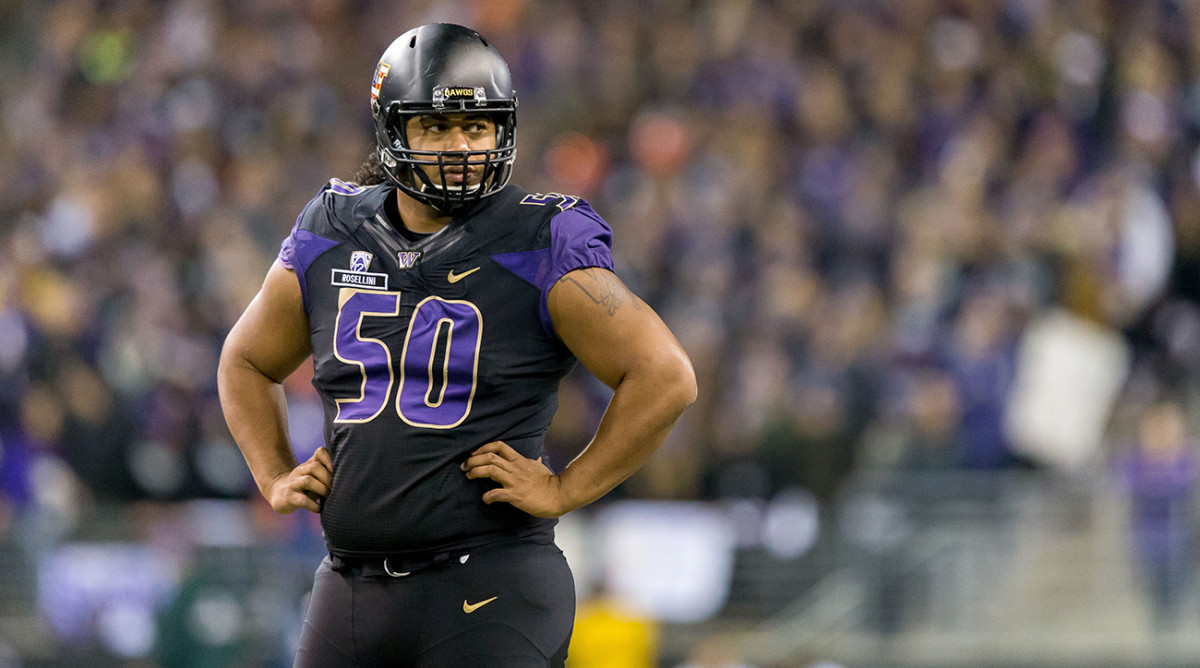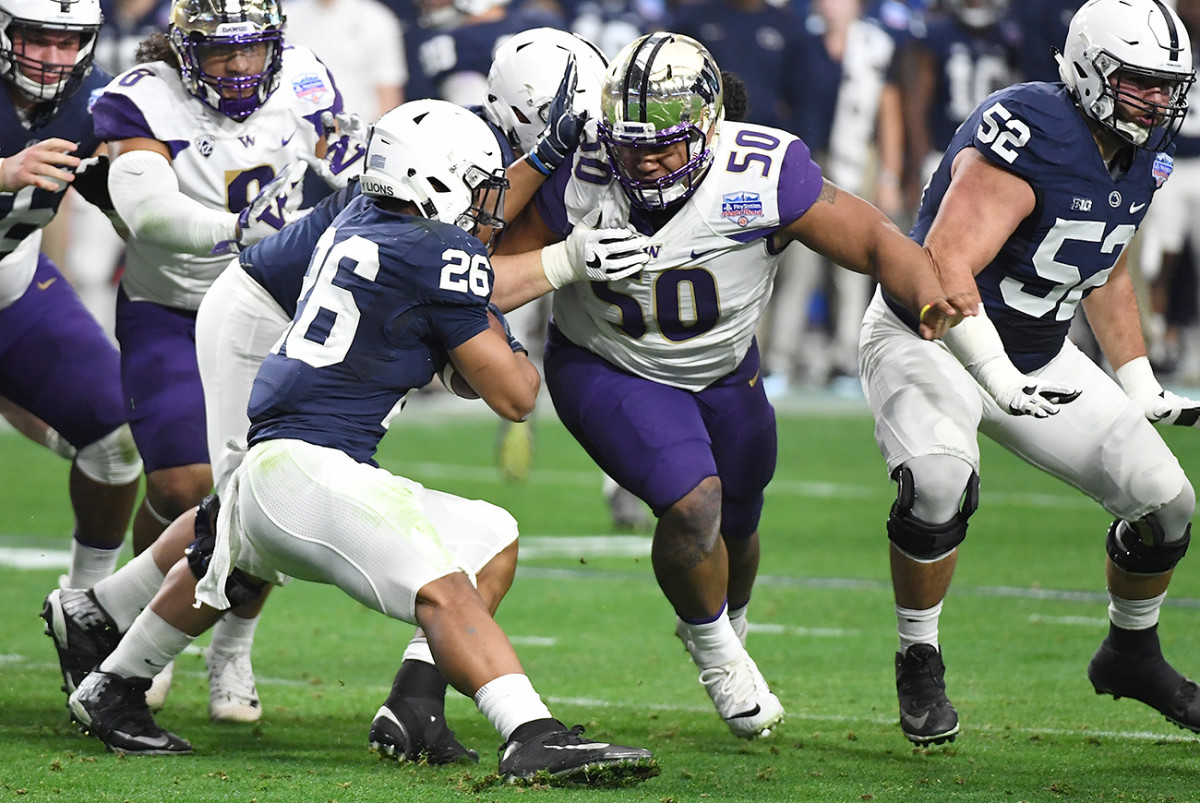When an Unstoppable Force Meets an Immovable Object, You Get Vita Vea

When Nick Harris arrived at Washington in the summer of 2016, he saw the continent wearing No. 50 and asked a veteran teammate what position Vita Vea played. Harris, a 270-pound (at the time) guard, prayed Vea was a fellow offensive lineman so he wouldn’t have to block him. The bad news soon arrived: He would have to clash with the 6' 5", 345-pound Vea every day at practice. “So this is what college D-linemen look like,” Harris thought to himself, resigned to spending the next four years slamming into a series of human brick walls.
Harris has since learned that no one else in college football looked—or played—like Vea.
He’s bigger than Danny Shelton, the former Washington defensive tackle the Browns selected 12th overall in 2015, but Huskies defensive coordinator Pete Kwiatkowski used Vea everywhere on the line. He played nose. He played on the inside and outside eye of the guard. He lined up at defensive end.
“His stats don’t tell the story of how destructive he is,” says Texas assistant Clay McGuire, who coached Washington State’s offensive line for the past six seasons and faced Vea three times. Indeed, Vea’s 2017 numbers were pedestrian (44 tackles, 5.5 tackles for loss, 3.5 sacks), but that didn’t stop Pac-12 head coaches from voting him the league’s Defensive Player of the Year. Those coaches voted for Vea because he ate up two and sometimes three blockers at a time and allowed linebackers to roam unhindered for a defense that led the conference and finished tied for third in the nation in yards per play allowed (4.42). They also voted for him because they spent game weeks wondering if he’d toss their offensive linemen into a handoff or chase down their tailbacks from behind. “It gets kind weird when you look at that film and you see a 340-pounder running with a 200-pound linebacker and we get to the ball at the same time,” Washington linebacker Keishawn Bierria says. “Something’s wrong here.” That’s probably what UCLA quarterback Josh Rosen thought this past season when he squirted through the line of scrimmage expecting a much bigger gain only to have Vea trip him up from behind. Shortly after that, UCLA’s left guard tried to pass off a stunting Vea to the left tackle, and Vea blew through both blockers and buried Rosen for a sack.
With the NFL combine underway, those who played with and against Vea are wondering one thing: What sort of absurd numbers will he post at the NFL combine? No defensive lineman has brought this combination of size, speed and strength to Indianapolis since Dontari Poe in 2012, but Vea was much more accomplished at Washington than Poe was at Memphis. Poe, who measured 6' 4" and 346 pounds, ran a 4.98-second 40-yard dash and pumped out 44 reps at 225 pounds on the bench press, his combine show fueling a rise up draft boards—the Chiefs selected him 11th overall. Could Vea run and lift himself into the top 10? Top five?
In McGuire’s mind, Vea has already entered select company. While coaching at Texas Tech a decade ago, McGuire’s players had to face Nebraska’s Ndamukong Suh and Oklahoma’s Gerald McCoy. Those two were dominant, but Vea’s ability to play anywhere on the line made it nearly impossible to create a game plan for him that wouldn’t get blown up when he moved from nose to end between plays or—on the occasions Kwiatkowski called for a twist stunt—he covered all that ground during a play. “It was the first time ever that we’ve ever had to adjust a protection during a game for one player,” McGuire said.

If Vea moves entirely too fast for a man his size at Lucas Oil Stadium, he’ll only be carrying on a tradition he started at Milpitas (Calif.) High. Vea made varsity at the Bay Area school as a 6' 3", 260-pound freshman. He moved so well that coach Kelly King played him at outside linebacker on defense. On offense? “He told me he was a wildcat quarterback,” King says. King let Vea play some quarterback in 2009. He even let him throw once—with disastrous results. Vea eventually settled into regular roles as a middle linebacker and change-of-pace tailback alongside future BYU back Squally Canada. King occasionally played him at tight end and on both lines of scrimmage, but Vea kept taking handoffs even as he approached 300 pounds.
Harris delighted in watching video of his monstrous teammate toting the ball as a high-schooler. “It looks like an NFL running back against a Pop Warner front seven,” Harris says. See for yourself:
Vea probably could have talked his way into a steady role in Washington’s offense. Alabama used likely first-round defensive tackle Da’Ron Payne as a goal-line fullback and as a pass-catching H-back. (Payne caught a touchdown pass against Clemson in the Sugar Bowl.) But while Vea hasn’t forgotten the thrill of scoring touchdowns, he didn’t want to jeopardize his development as a defensive lineman. “Not at [the major college] level,” Vea said of moonlighting as a back. “Too many guys would be going for my legs. Save the legs.”
The most amazing play King saw Vea make in high school started with Vea playing fullback against Wilcox High in 2012. The Trojans’ quarterback and tailback botched a handoff, and the ball bounced into the hands of Wilcox safety Delshawn Mitchell. Mitchell, who also was Wilcox’s star tailback, sprinted the other direction with a head start. It took 50 yards, but Vea ran down Mitchell to save a touchdown. “The look on the guy’s face,” King says. “He couldn’t believe anybody caught him, let alone Vita.”
Want to see that? Click play and scroll to the 1:16 mark.
It took a while before Vea could perform a similar feat at the college level. He didn’t qualify academically after graduating high school in 2013, so he delayed his enrollment at Washington until 2014. He redshirted his first season in Seattle. In his second, he backed up Elijah Qualls and Taniela Tupou. He didn’t come into his own until his redshirt sophomore year in 2016. With Qualls and Gaines also in the rotation that year, Washington’s opponents had to decide whom to double-team. Vea was still raw, but his power and speed were unmistakable.
And that made life miserable for the freshman who attempted to block him in practice. “It’s almost impossible to get movement on that guy,” Harris says. “He’s 6' 5" and 350 pounds and he’s as explosive as a 230-pound linebacker.” Harris learned to grade himself on a curve against Vea. “If you stonewall Vita, that’s a win,” Harris said. “If he doesn’t push you back, that’s a win.” As a redshirt junior in 2017, Vea seemed more technically proficient, and his increased knowledge of opposing offenses allowed Kwiatkowski to move him around more. No longer was a he a massive freak athlete using his natural gifts to make plays. He knew why he was lined up outside, or twisting out on a stunt, and that made him more dangerous.
But the attribute that should entice NFL general managers is Vea’s fundamental immovability. His speed is merely a bonus; Vea excels at football’s most basic level. The offense needs to put him in a place he doesn’t want to go, and he won’t let that happen. Few humans can combine the strength and leverage to move him backward by themselves. Vea can destroy a zone-blocking scheme because the moment one of the blockers from the initial double team peels off to hit the linebacker, Vea will club the remaining blocker, shed him and attack the ballcarrier. That he developed pass rush moves beyond the obvious bull rush is a plus, but even if he hadn’t, his most basic skills would still be incredibly valuable.

Vea still can refine his game. When he does get free, he can get knocked off track by blockers with a head of steam. He doesn’t burst off the line of scrimmage like the best pass rushers do. It takes a beat for him to get engaged. But once his hands get into a blocker’s chest, Vea’s gap is secure. He also engages in the very good habit—unusual for someone so big—of running to the ball on every play. That teenage fullback who chased down the safety on the fumble return is still part of the man about to enter the NFL. Perhaps four years of reminders from Washington coach Chris Petersen ensured that. “We’re always running to the ball,” Vea says, “so Pete doesn’t yell at us.”
A few days before Washington faced Penn State in the Fiesta Bowl, Vea’s final college game, Nittany Lions coach James Franklin had some advice for his upcoming opponent: “It probably makes sense for him just to declare to the NFL now,” Franklin joked. Vea politely declined and forced Franklin’s team to block him. “He's able to make the play at the line of scrimmage by really creating a stalemate and ditching the guy at the last second and making a tackle,” Franklin said. “The other thing that's so advantageous having guys like that inside is it puts the linebackers in a great situation, because those defensive linemen are not getting pushed into their face.”
To that, Washington linebacker Bierria says, amen. “It means I’m free,” Bierria says. “He’s my bodyguard. He’s taking up two or three.”
If he performs as freakishly as expected at the combine, Vea’s bodyguard services won’t come cheap. But to the linebackers who will run free behind him—and sometimes lose the race to the ball to him—he’ll be invaluable.
• Question or comment? Email us at talkback@themmqb.com.
